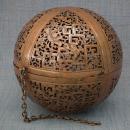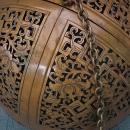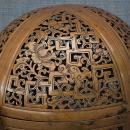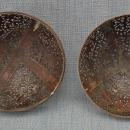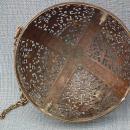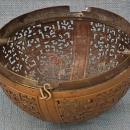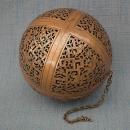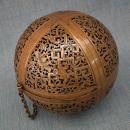Antique Chinese 17th Century Ming Dynasty Copper Spherical Incense Burner Censer



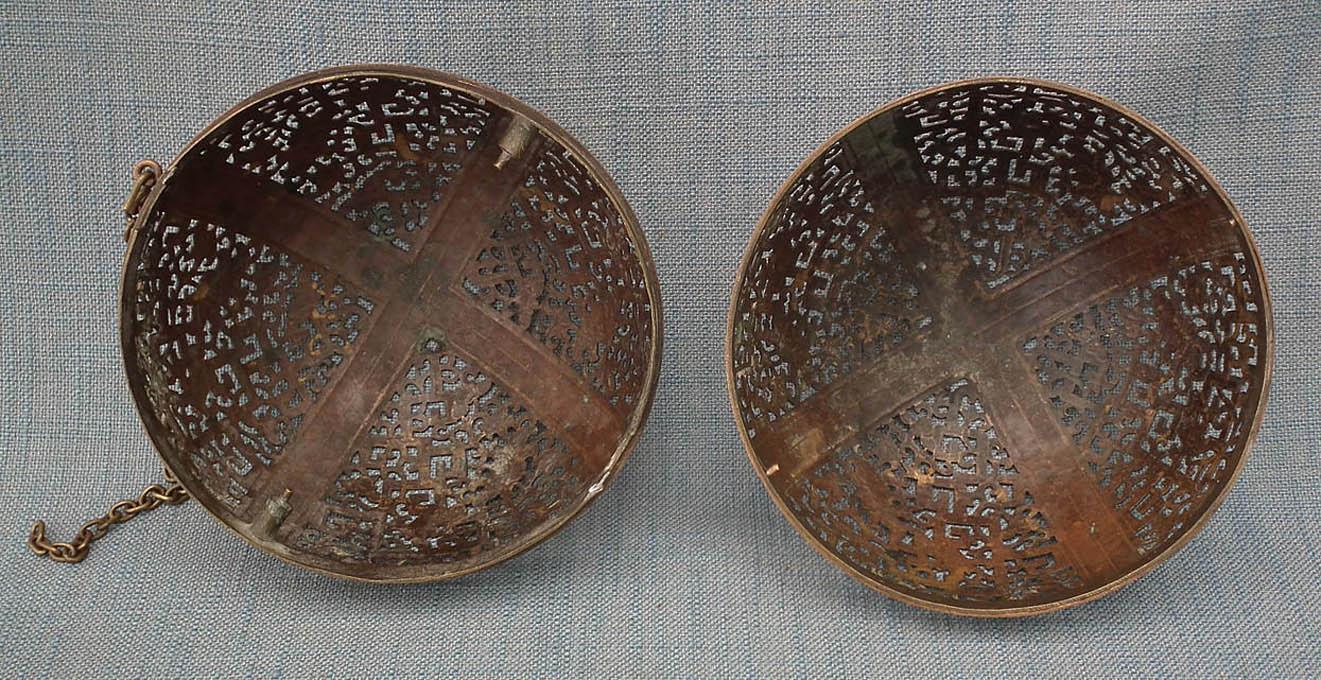




$4,200.00
Or Best OfferAntique Chinese 17th century, late Ming dynasty, copper spherical incense burner – censer (Xiangnang) attributed to Zhang Mingqi. The delicately hand hammered, spherical body is composed of two identical hemispheres joined by a bayonet fitting, divided into eight quadrants, finely hand pierced and chiseled with dragon heads, stylized archaic scrolls, peonies, and tendrils. The censer is affixed with a loop and a short, linked suspension chain. The surface of the copper was patinated to a warm caramel-brown tone.
The interior of the censer is affixed with two bolts attached to one half for mounting the gimbal device (missing), which is compos of a center incense brazier in the form of a small cup slung on three rings one inside the other (gimbals) to stabilize the burning coal or incense in the suspended container.
To ensure that the central brazier with the incense remained upright even when the incense burner was rolled around, each ring bears the pivots of the others. Therefore, the incense will never drop out, no matter how the brazier is turned.
Sotheby's sold a similar spherical incense burner in Hong Kong on April 22, 2021, as part of its "Important Chinese Art" sales. Lot 3679.
Estimate: 40,000 - 60,000 HKD. Lot sold: 52,920 HKD.
Please see the link below:
https://www.sothebys.com/en/buy/auction/2021/important-chinese-art/a-bronze-openwork-spherical-incense-burner-late
This rare openwork incense burner, known as Xunqiu, appeared in the Tang dynasty. The skillful technique on the current incense burner seems to relate to the high-quality craftsmanship of late Ming era copper artifacts, created by Zhang Mingqi, from Jiaxing, Zhejiang.
Zhang Mingqi: A native of Jiaxing in Zhejiang province, Zhang Mingqi was regarded as one of the four greatest craftsmen of the late Ming dynasty. While the other three specialized in crafts including bamboo carving, Yixing pottery, and shell carving and inlay, Zhang was the most well-known producer of exclusive copper artifacts in the late Ming dynasty. He typically worked with red copper and often used a hammering technique to shape his works. He was also known for creating components that fit together perfectly, due to his attention to precision.
Xiangnang censer spread to the Islamic world in the late 12th century and was most frequently found in Egypt and Syria during the 13th and 14th centuries (in the Islamic world, the Mamluk period 1250-1517), which corresponds to the Mongol Yuan dynasty (1271–1368) in China.
Before the 12th or 13th century, there is no conclusive evidence that people in Europe or the Islamic world were aware of the gimbal-powered, spherical incense burner invented in China.
To view the Islamic spherical incense burner, please see the link below:
https://www.metmuseum.org/art/collection/search/447019?img=6
CONDITION: In very good condition, with spots of old green patina. No dents or repairs. Absence of the gimbal device.
MEASUREMENTS: Horizontal diameter: 16.5 cm (6.5 inches)
WEIGHT: 611 grams.
PROVENANCE: From an old Canadian Collection of Oriental Art.
In my more than 55 years of involvement in the antique trade, this is the first time I have seen another 17th-century bronze spherical incense burner of this type for sale, except for the one sold by Sotheby's, proving it to be extremely rare.
Another similar Ming dynasty spherical bronze censer is in the collection of the Chinese National Museum in Beijing. <P>
For more information on Chinese spherical incense burners, please see "The Religious and Technological History of the Tang Dynasty Spherical Incense Burner" by Dr. Bing Huang.
Link: https://www.mdpi.com/2077-1444/13/6/482
The censer is accompanied by a Certificate of Authenticity.
